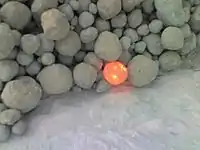Cement clinker
Cement clinker is a solid material produced in the manufacture of Portland cement as an intermediary product. Clinker occurs as lumps or nodules, usually 3 millimetres (0.12 in) to 25 millimetres (0.98 in) in diameter. It is produced by sintering (fusing together without melting to the point of liquefaction) limestone and aluminosilicate materials such as clay during the cement kiln stage.


Composition and preparation
Clinker consists of various calcium silicates including alite and belite. Tricalcium aluminate and calcium aluminoferrite are other common components. These components are often generated in situ by heating various clays and limestone.[1]
Portland cement clinker is made by heating a homogeneous mixture of raw materials in a rotary kiln at high temperature . The products of the chemical reaction aggregate together at their sintering temperature, about 1,450 °C (2,640 °F). Aluminium oxide and iron oxide are present only as a flux to reduce the sintering temperature and contribute little to the cement strength. For special cements, such as low heat (LH) and sulfate resistant (SR) types, it is necessary to limit the amount of tricalcium aluminate formed. The major raw material for the clinker-making is usually limestone mixed with a second material containing clay as a source of alumino-silicate. Normally, an impure limestone which contains clay or silicon dioxide (SiO2) is used. The calcium carbonate (CaCO3) content of these limestones can be as low as 80%. Second raw materials (materials in the rawmix other than limestone) depend on the purity of the limestone. Some of the second raw materials used are: clay, shale, sand, iron ore, bauxite, fly ash and slag. The clinker surface and its reactions in different electrolytic solutions are investigated by scanning electron microscope and atomic force microscopy.[2]
Uses
Portland cement clinker is ground to a fine powder and used as the binder in many cement products. A little gypsum is sometimes added. It may also be combined with other active ingredients or chemical admixtures to produce other types of cement including:
- ground granulated blast furnace slag cement
- pozzolana cement
- silica fume cement
Clinker, if stored in dry conditions, can be kept for several months without appreciable loss of quality. Because of this, and because it can easily be handled by ordinary mineral handling equipment, clinker is traded internationally in large quantities. Cement manufacturers purchasing clinker usually grind it as an addition to their own clinker at their cement plants. Manufacturers also ship clinker to grinding plants in areas where cement-making raw materials are not available.
Clinker grinding aids
Gypsum is added to clinker primarily as an additive preventing the flash settings of the cement, but it is also very effective to facilitate the grinding of clinker by preventing agglomeration and coating of the powder at the surface of balls and mill wall.
Organic compounds are also often added as grinding aids to avoid powder agglomeration. Triethanolamine (TEA) is commonly used at 0.1 wt. % and has proved to be very effective. Other additives are sometimes used, such as ethylene glycol, oleic acid, and dodecyl-benzene sulfonate.[3]
Conversion to cement paste
Upon treatment with water, clinker reacts to form a hydrate called cement paste. Upon standing the paste polymerizes as indicated by its hardening.
Contribution to global warming
As of 2018, cement production contributed about 8% of all carbon emissions worldwide, contributing substantially to global warming. Most of those emissions were produced in the clinker manufacturing process.[4]
See also
References
- Siegbert Sprung "Cement" in Ullmann's Encyclopedia of Industrial Chemistry, 2012 Wiley-VCH, Weinheim. doi:10.1002/14356007.a05_489.pub2
- Ferrari, L. (2012). "Reaction of clinker surfaces investigated with atomic force microscopy". Construction and Building Materials. 35: 92–96. doi:10.1016/j.conbuildmat.2012.02.089.
- Sohoni, S.; R. Sridhar; G. Mandal (1991). "Effect of grinding aids on the fine grinding of limestone, quartz and portland cement clinker". Powder Technology. 67 (3): 277–286. doi:10.1016/0032-5910(91)80109-V.
- Rodgers, Lucy (2018-12-17). "The massive CO2 emitter you may not know about". BBC News. Retrieved 2018-12-17.